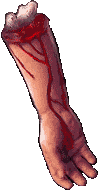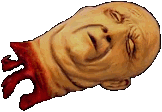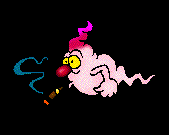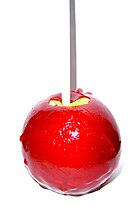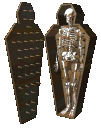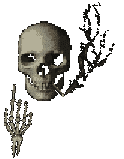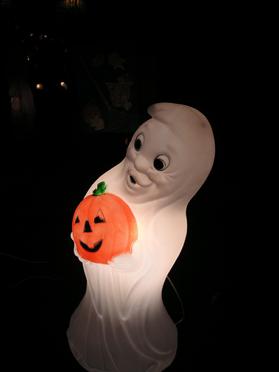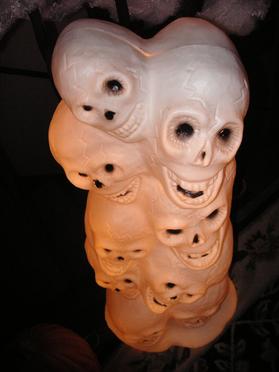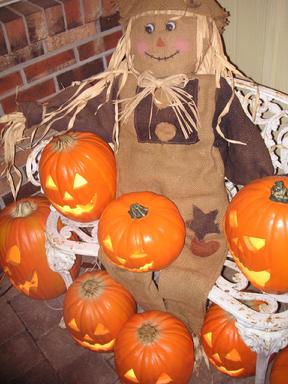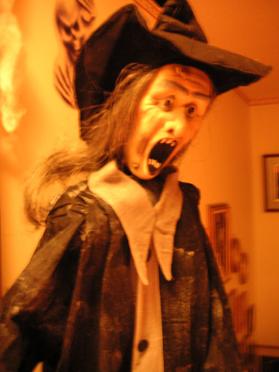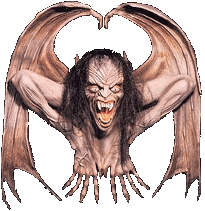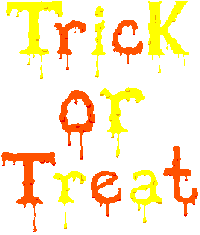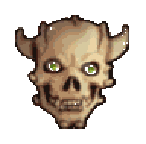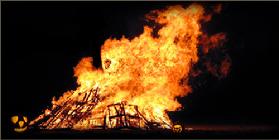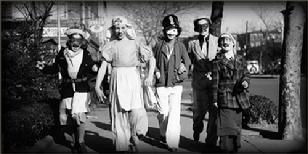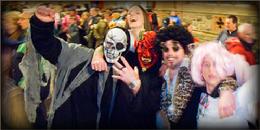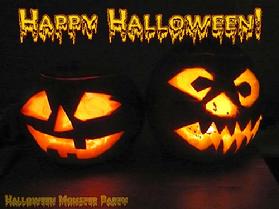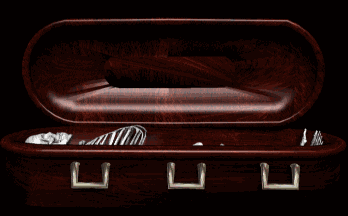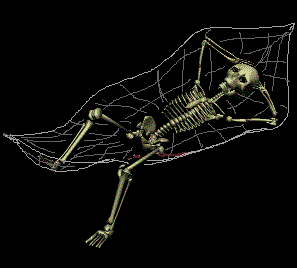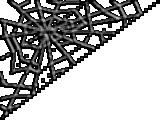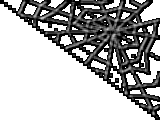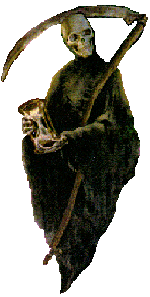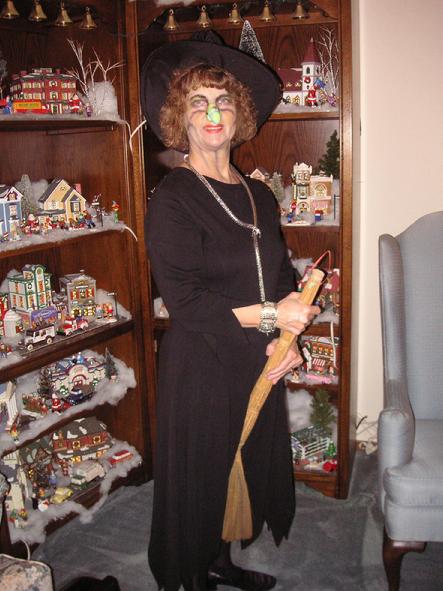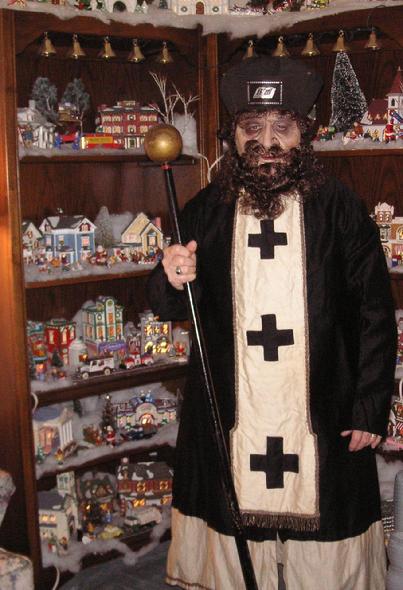| Halloween |
|---|
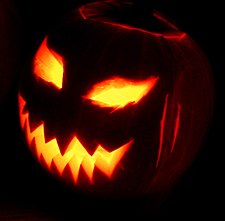
A Jack-o'-lantern |
| Also called |
All Hallows’ Eve
All Saints’ Eve |
|---|
| Observed by |
Around the world |
|---|
| Type |
Secular, with roots in Christian and Celtic tradition |
|---|
| Date |
October 31 |
|---|
| Observances |
Costume parties, trick-or-treating in costumes, bonfires, divination, apple bobbing. |
|---|
| Related to |
Samhain, All Saints’ Day |
|---|
Halloween (also spelled Hallowe'en) is an annual holiday celebrated on October 31. It has roots in the Celtic festival of Samhain and the Christian holy day of All Saints, but is today largely a secular celebration.
Halloween activities include trick-or-treating, wearing costumes and attending costume parties, carving jack-o'-lanterns, ghost tours, bonfires, apple bobbing, visiting haunted attractions, pranks, telling scary stories, and watching horror films.
History
Historian Nicholas Rogers, exploring the origins of Halloween, notes that while "some folklorists have detected its origins in the Roman feast of Pomona, the goddess of fruits and seeds, or in the festival of the dead called Parentalia, it is more typically linked to the Celtic festival of Samhain original spelling was Samuin (pronounced sow-an or sow-in)". The name is derived from Old Irish and means roughly "summer's end". A similar festival was held by the ancient Britons and is known as Calan Gaeaf (pronounced Kálan Gái av).
Snap-Apple Night by Daniel Maclise showing a Halloween party in Blarney, Ireland, in 1832. The young children on the right bob for apples. A couple in the center play a variant, which involves retrieving an apple hanging from a string. The couples at left play divination games.
The festival of Samhain celebrates the end of the "lighter half" of the year and beginning of the "darker half", and is sometimes regarded as the "Celtic New Year".
The ancient Celts believed that the border between this world and the Otherworld became thin on Samhain, allowing spirits (both harmless and harmful) to pass through. The family's ancestors were honoured and invited home whilst harmful spirits were warded off. It is believed that the need to ward off harmful spirits led to the wearing of costumes and masks. Their purpose was to disguise oneself as a harmful spirit and thus avoid harm.
In Scotland the spirits were impersonated by young men dressed in white with masked, veiled or blackened faces. Samhain was also a time to take stock of food supplies and slaughter livestock for winter stores. Bonfires played a large part in the festivities. All other fires were doused and each home lit their hearth from the bonfire. The bones of slaughtered livestock were cast into its flames. Sometimes two bonfires would be built side-by-side, and people and their livestock would walk between them as a cleansing ritual.
Another common practise was divination, which often involved the use of food and drink.
The name 'Halloween' and many of its present-day traditions derive from the Old English era.
Origin of name
The word Halloween is first attested in the 16th century and represents a Scottish variant of the fuller All-Hallows-Eve, that is, the night before All Hallows Day. Although the phrase All Hallows is found in Old English (ealra hálȝena mæssedæȝ, the feast of all saints), All-Hallows-Even is itself not attested until 1556. Thus there is no evidence of the term for this day before the 16th century Reformation.
Symbols

A traditional Irish halloween turnip Jack-o'-lantern from the early 20th century on display in the Museum of Country Life, Ireland.
Development of artifacts and symbols associated with Halloween formed over time encompassing customs of medieval holy days as well as contemporary cultures. The souling practice of commemorating the souls in purgatory with candle lanterns carved from turnips, became adapted into the making of jack-o'-lanterns. In traditional Celtic Halloween festivals, large turnips were hollowed out, carved with faces and placed in windows to ward off evil spirits. The carving of pumpkins is associated with Halloween in North America where pumpkins are both readily available and much larger – making them easier to carve than turnips. Many families that celebrate Halloween carve a pumpkin into a frightening or comical face and place it on their doorstep after dark. The American tradition of carving pumpkins preceded the Great Famine period of Irish immigration and was originally associated with harvest time in general, not becoming specifically associated with Halloween until the mid-to-late 1800s.

Halloween spiders at a row house in Washington DC
The imagery of Halloween is derived from many sources, including national customs, works of Gothic and horror literature (such as the novels Frankenstein and Dracula), and classic horror films (such as Frankenstein and The Mummy). Elements of the autumn season, such as pumpkins, corn husks, and scarecrows, are also prevalent. Homes are often decorated with these types of symbols around Halloween.
Halloween imagery includes themes of death, evil, the occult, magic, or mythical monsters.Traditional characters include ghosts, witches, skeletons, vampires, werewolves, bats, and black cats. The colours black and orange are associated with the celebrations, perhaps because of the darkness of night and the colour of fire, autumn leaves, or pumpkins.
Trick-or-treating and guising
Trick-or-treating is a customary celebration for children on Halloween. Children go in costume from house to house, asking for treats such as candy or sometimes money, with the question, "Trick or treat?" The word "trick" refers to a (mostly idle) "threat" to perform mischief on the homeowners or their property if no treat is given. In some parts of Scotland children still go guising. In this custom the child performs some sort of trick, i.e. sings a song or tells a ghost story, to earn their treats.
Costumes
Main article: Halloween costume
Halloween costumes are traditionally those of monsters such as ghosts, skeletons, witches, and devils. They are said to be used to scare off demons. Costumes are also based on themes other than traditional horror, such as those of characters from television shows, movies, and other pop culture icons.
Costume sales
BIG research conducted a survey for the National Retail Federation in the United States and found that 53.3% of consumers planned to buy a costume for Halloween 2005, spending $38.11 on average (up $10 from the year before). They were also expected to spend $4.96 billion in 2006, up significantly from just $3.3 billion the previous year.
UNICEF
"Trick-or-Treat for UNICEF" has become a common sight during Halloween in North America. Started as a local event in a Philadelphia suburb in 1950 and expanded nationally in 1952, the program involves the distribution of small boxes by schools (or in modern times, corporate sponsors like Hallmark, at their licensed stores) to trick-or-treaters, in which they can solicit small-change donations from the houses they visit. It is estimated that children have collected more than $118 million for UNICEF since its inception. In Canada, in 2006, UNICEF decided to discontinue their Halloween collection boxes, citing safety and administrative concerns; after consultation with schools, they instead redesigned the program.
Games and other activities
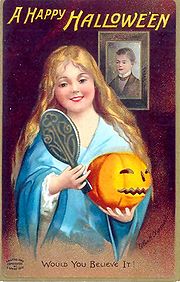
In this Halloween greeting card from 1904, divination is depicted: the young woman looking into a mirror in a darkened room hopes to catch a glimpse of the face of her future husband.
There are several games traditionally associated with Halloween parties. One common game is dunking or apple bobbing, in which apples float in a tub or a large basin of water and the participants must use their teeth to remove an apple from the basin.A variant of dunking involves kneeling on a chair, holding a fork between the teeth and trying to drop the fork into an apple. Another common game involves hanging up treacle or syrup-coated scones by strings; these must be eaten without using hands while they remain attached to the string, an activity that inevitably leads to a very sticky face.
Some games traditionally played at Halloween are forms of divination. A traditional Scottish form of divining one's future spouse is to carve an apple in one long strip, then toss the peel over one's shoulder. The peel is believed to land in the shape of the first letter of the future spouse's name. Unmarried women were told that if they sat in a darkened room and gazed into a mirror on Halloween night, the face of their future husband would appear in the mirror. However, if they were destined to die before marriage, a skull would appear. The custom was widespread enough to be commemorated on greeting cards from the late 19th and early 20th centuries.
The telling of ghost stories and viewing of horror films are common fixtures of Halloween parties. Episodes of television series and Halloween-themed specials (with the specials usually aimed at children) are commonly aired on or before the holiday, while new horror films are often released theatrically before the holiday to take advantage of the atmosphere.
Haunted attractions

In front of haunted house during Halloween season, Northern California.
Haunted attractions are entertainment venues designed to thrill and scare patrons. Most attractions are seasonal Halloween businesses. Origins of these paid scare venues are difficult to pinpoint, but it is generally accepted that they were first commonly used by the Junior Chamber International (Jaycees) for fundraising.[27] They include haunted houses, corn mazes, and hayrides, and the level of sophistication of the effects has risen as the industry has grown. Haunted attractions in the United States bring in an estimate $300–500 million each year, and draw some 400,000 customers, although trends suggest a peak in 2005. This increase in interest has led to more highly technical special effects and costuming that is comparable with that in Hollywood films.
Foods
Because the holiday comes in the wake of the annual apple harvest, candy apples (known as toffee apples outside North America), caramel or taffy apples are a common Halloween treat made by rolling whole apples in a sticky sugar syrup, sometimes followed by rolling them in nuts.
At one time, candy apples were commonly given to children, but the practice rapidly waned in the wake of widespread rumors that some individuals were embedding items like pins and razor blades in the apples.
While there is evidence of such incidents, they are quite rare and have never resulted in serious injury. Nonetheless, many parents assumed that such heinous practices were rampant. At the peak of the hysteria, some hospitals offered free x-rays of children's Halloween hauls in order to find evidence of tampering. Virtually all of the few known candy poisoning incidents involved parents who poisoned their own children's candy, and there have been occasional reports of children putting needles in their own (and other children's) candy in need of a bit of attention.
One custom that persists in modern-day Ireland is the baking (or more often nowadays, the purchase) of a barmbrack (Irish: báirín breac), which is a light fruitcake, into which a plain ring, a coin and other charms are placed before baking. It is said that those who get a ring will find their true love in the ensuing year. This is similar to the tradition of king cake at the festival of Epiphany.
List of foods associated with the holiday:
- Barmbrack (Ireland)
- Bonfire toffee (Britain)
- Candy apples
- Candy corn (North America)
- Caramel apples
- Caramel corn
- Colcannon (Ireland)
- Pumpkin, pumpkin pie, pumpkin bread
- Roasted pumpkin seeds
- Roasted sweet corn
- Soul cakes
- Novelty candy shaped like skulls, pumpkins, bats, worms, etc.
Around the world
Main article: Halloween around the world
Halloween is not celebrated in all countries and regions of the world, and among those that do the traditions and importance of the celebration vary significantly. Celebration in the United States has had a significant impact on how the holiday is observed in other nations. This larger American influence, particularly in iconic and commercial elements, has extended to places such as South America, Europe, to Japan under the auspices of the Japanese Biscuit Association, and the Far East.
Religious perspectives
Christianity
Christian attitudes towards Halloween are quite diverse. In the Anglican Church, some dioceses have chosen to emphasize the Christian traditions of All Saints’ Day, while some other Protestants celebrate the holiday as Reformation Day, a day to remember the Protestant Reformation.
Many Christians ascribe no negative significance to Halloween, treating it as a purely secular holiday devoted to celebrating "imaginary spooks" and handing out candy. Halloween celebrations are common among Roman Catholic parochial schools throughout North America and in Ireland. In fact, the Roman Catholic Church sees Halloween as having a Christian connection. Father Gabriele Amorth, a Vatican-appointed exorcist in Rome, has said, "If English and American children like to dress up as witches and devils on one night of the year that is not a problem. If it is just a game, there is no harm in that.
MostChristians hold the view that the tradition is far from being satanic in origin or practice and that it holds no threat to the spiritual lives of children: being taught about death and mortality, and the ways of the Celtic ancestors actually being a valuable life lesson and a part of many of their parishioners' heritage. Other Christians feel concerned about Halloween, and reject the holiday because they believe it trivializes (and celebrates) "the occult" and what they perceive as evil. A response among some fundamentalists in recent years has been the use of 'Hell houses' or themed pamphlets (such as those of Jack T. Chick) which attempt to make use of Halloween as an opportunity for evangelism.
Some consider Halloween to be completely incompatible with the Christian faith because of its origin as a pagan "Festival of the Dead." In more recent years, the Roman Catholic Archdiocese of Boston has organized a "Saint Fest" on the holiday. Many contemporary Protestant churches view Halloween as a fun event for children, holding events in their churches where children and their parents can dress up, play games, and get candy. Jehovah's Witnesses do not celebrate Halloween because they believe anything that originated from a pagan holiday should not be celebrated by true Christians.
Islam
In Islam, Halloween is viewed as a holiday with pagan roots. Any association with or celebration of Halloween is thus forbidden.
Judaism
Halloween is seen as a pagan festival, and is hence not celebrated in Judaism.
Paganism
Celtic Pagans consider the season a holy time of year. Celtic Reconstructionists, and others who maintain ancestral customs, make offerings to the gods and the ancestors. Some Wiccans feel that the tradition is offensive to "real witches" for promoting stereotypical caricatures of "wicked witches".


